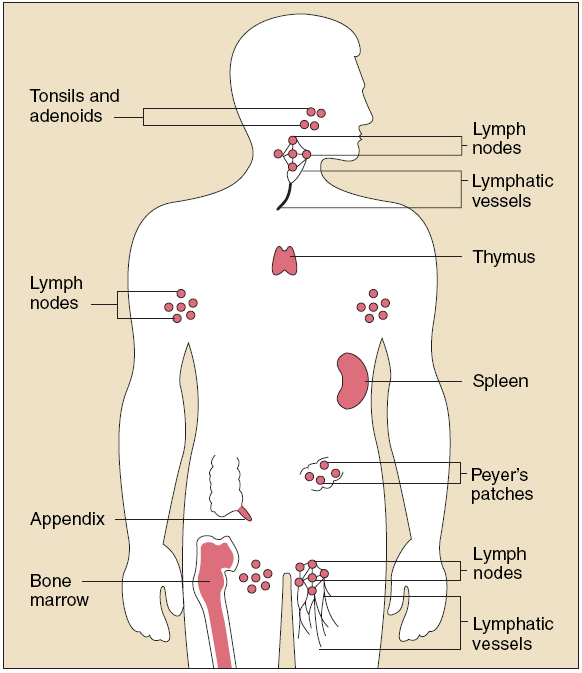 |
| http://www.livehealthynaturally.info/ImmuneSystem.jpg |
The major organs of the Immune System are:
Thymus: The purpose of the Thymus is to take part in the production, training, and development of T-lymphocytes or T-cells. These are extremely important white blood cells that are involved in protecting the body against both infectious disease and foreign invaders.
Bone Marrow: The Bone Marrow replaces unhealthy blood stem cells with healthy blood stem cells. These cells are also known as blood-forming cells. They are immature cells that can grow into red blood, white blood cells, and platelets.
Spleen: The Spleen contains white blood cells that fight infection or disease. In addition, the spleen also helps control the amount of blood in the body and disposes of old or damaged blood cells.
Lymph Nodes: The function of Lymph Nodes is to produce and store cells that fight infection and disease. In addition, Lymph Nodes also contain lymph, the clear fluid that carries those cells to different parts of the body. When the body is fighting infection, lymph nodes can become enlarged and feel sore.
The Immune System works with the Circulatory System and the Integumentary System. The Immune System interacts with the Circulatory by working together to maintain homeostasis by removing any foreign cells. This is because the Circulatory System continuously sends blood and essential substances through the entire body. Such as white blood cells from the Immune System. The Immune System works with the Integumentary System because the skin is one of the first defense mechanisms in the Immune System. There are cells and compounds on the skin that help to kill any bacteria that appear. Usually, the skin will get dangerous bacteria and viruses before the lungs breathe in these microorganisms.
Analogy
The Immune System is like an army because ...
 |
| http://www.military.ie/uploads/tx_templavoila/army.jpg |
- it is a defense force
- it is weak if something is missing
- it works as a team
- it needs training to become strong
The Immune System is like an army because both are defense forces. The Immune System defends the body like how an army defends their country. In addition, the Immune System is like an army because both perform and function as a team by working together. Also, both don't function properly if a part of their whole team is missing. If the bone marrow fails to function, the production of white blood cells and red blood cells will lack. This means that the Immune System won't be able to protect the body from infectious disease and foreign invaders properly. This is much like how if a group of soldiers aren't working, the whole army wouldn't be able to protect their country as well. Lastly, both need training to become strong. The Immune System needs to encounter a certain disease before learning how to defend against it's virus like how the soldiers of an army need to train to use certain equipment in order to know what to do in specific situations.
Structure and Function
The main function of the Bone Marrow is to generate blood cells. These cells including red blood cells and white blood cells. The Bone Marrow contains two main types of stem cells, Hematopoietic stem cells and Mesenchymal stem cells. Hematopoietic stem cells are found in red marrow and are responsible for the production of blood cells. While Mesenchymal stem cells produce the non-blood cell components of marrow, including fat, cartilage, fibrous connective tissue, stromal cells that support blood formation, and bone cells. Knowing this information, I believe that because the Bone Marrow contains these stem cells in it's structure, that it is able to produce blood cells and many other components. I believe this is why Bone Marrow is responsible for the production of red blood cells and white blood cells.
Sources:
No comments:
Post a Comment